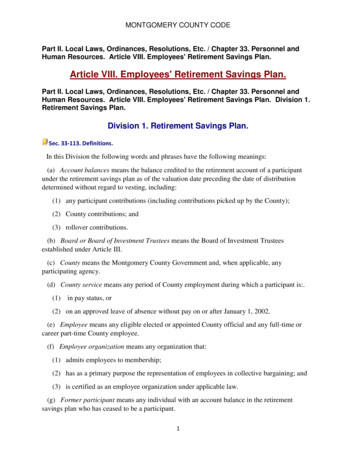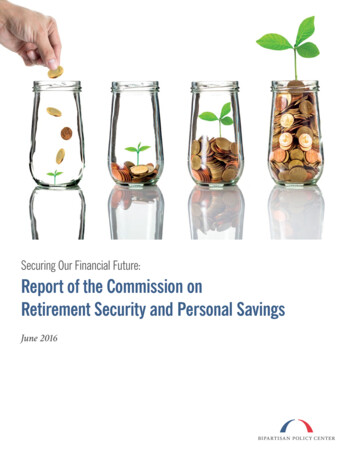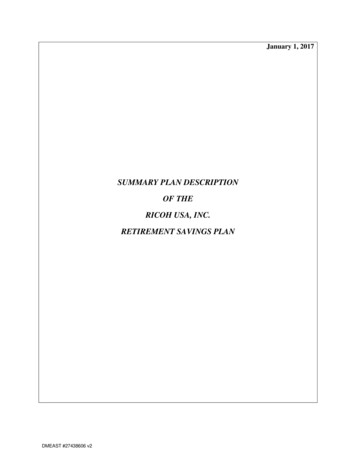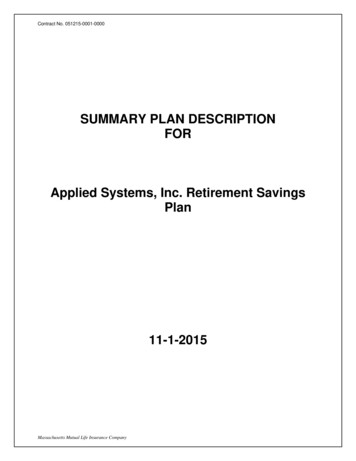
Transcription
University of KonstanzDepartment of EconomicsOptimal Savings for Retirement:The Role of Individual AccountsJulia Le Blanc and Almuth SchollWorking Paper oc/working-paper-series/
Optimal Savings for Retirement: The Role of IndividualAccounts Julia Le BlancDeutsche BundesbankAlmuth SchollUniversity of KonstanzMay 5, 2015AbstractWe employ a life-cycle model with income risk to analyze how tax-deferred individual accountsaffect households’ savings for retirement. We consider voluntary accounts as opposed to mandatory accounts with minimum contribution rates. We contrast add-on accounts with carve-outaccounts that partly replace social security contributions. Quantitative results suggest that making add-on accounts mandatory has adverse welfare effects across income groups. Carve-outaccounts generate positive welfare across all income groups but gains are lower for low incomeearners. Default investment rules in individual accounts have a modest impact on welfare.Keywords:JEL-Codes:individual retirement accounts, household portfolio choice,consumption and saving over the life-cycleE21, H55, G11 Previous versions of this paper were circulated under the title ‘Pension Reform and Individual Accounts’ and ‘OptimalSavings for Retirement: The Role of Individual Accounts and Disaster Expectations’. We thank two anonymous referees,Michael Haliassos, seminar participants at the Deutsche Bundesbank, participants at the International Netspar PensionWorkshop 2011, the Meeting of the Canadian Economic Association 2010 and the Meetings of the European EconomicAssociation 2009 for very useful comments and suggestions. The usual disclaimer applies. Please address correspondenceto julia.le.blanc@bundesbank.de or almuth.scholl@uni-konstanz.de.
1IntroductionIn many countries tax-deferred individual accounts have become an increasingly important component of the social security system. Around the world, different pension systems feature different typesof defined contribution plans. While in the U.S. IRAs or 401(k) plans are voluntary, other countriessuch as Sweden, Denmark and Australia recently introduced individual accounts that require compulsory contributions that co-exist with the unfunded public pension system. In contrast, in the UKand Japan, households can decide whether they contribute to the public retirement system or whetherthey “contract-out” into approved personal pension plans that fully or partially replace social securitycontributions. Since in 2001 the President’s Commission suggested to include mandatory individual accounts in the social security system, there has been an ongoing policy debate on the role ofindividual accounts in the U.S. pension system.1This paper employs a life-cycle model with exogenous stochastic labor income calibrated to theU.S. to analyze how different types of tax-deferred individual accounts affect households’ consumption, savings and portfolio allocation decisions as well as welfare. Our life-cycle model of portfoliochoice builds on Gomes, Michaelides and Polkovnichenko (2009) and Dammon, Spatt and Zhang(2004) and assumes that households can save in a taxable as well as an illiquid, tax-deferred account.In line with the literature on limited stock holding, in order to hold risky assets in the taxable accounthouseholds need to pay a fixed stock market entry fee. In contrast, investing in stocks is costless inthe tax-deferred account. We follow the categorization of Turner (2006) and consider three differenttypes of individual accounts. First, as in Gomes et al. (2009), households can save voluntarily in theindividual account. Second, households are required to make compulsory minimum contributions tothe individual account on top of their contributions to the public defined-benefit retirement system.Third, households carve out into mandatory individual accounts that replace part of the public socialsecurity system. In this scenario, households get a rebate on their contributions to the public pensionsystem but are required to invest that amount in the funded individual account.Our quantitative results show that households save in voluntary individual accounts for two reasons.First, taxation is deferred, i.e., taxes are paid upon withdrawal, and, second, the retirement accountprovides a costless access to risky assets yielding a risk premium. On the other hand, retirementaccounts are illiquid, and in our model households cannot withdraw funds until retirement age. Inline with Gomes et al. (2009) and Pries (2007) our simulation results show that early in life households1See President’s Commission to Strengthen Social Security (2001) and Geanakoplos and Zeldes (2009).2
save little in the illiquid account but from age 35 the contributions to the individual account start torise such that retirement wealth follows a hump shape over the life cycle.If households are required to hold mandatory add-on accounts with a compulsory minimum contribution rate, they are forced to invest more for retirement in younger years when they would ratherconsume than save. Making retirement savings mandatory that households would voluntarily undertake at later stages in life generates welfare losses of roughly 1.5 % of certainty-equivalent consumption. Comparing add-on and carve-out accounts reveals that the latter generate higher savings in theindividual account as well as in the liquid taxable account due to the positive income effect of therebate on the social security contributions. In retirement, when households have lower income fromthe public pension system, they use their private retirement wealth to compensate for the loss. Ouranalysis suggests that carve-out accounts have positive welfare effects across income groups becauseof the benefits of converting social security contributions into individually managed accounts withoptimally chosen risky portfolio shares. However, welfare gains are lower for low income earnersbecause they face limited benefits from the tax deferral.In view of the recent financial turmoil, it has become particularly important to understand the influence of stock market crashes on households’ retirement savings, their portfolio choice, and the role ofindividual accounts.2 Household wealth data suggest that households have substantially reduced theirstock market exposure since the early 2000s. In order to capture the effects of a financial downturn,we incorporate the risk of losing retirement benefits due to a financial market downturn and analyzethe impact of disaster expectations on optimal retirement savings in individual accounts. FollowingAlan (2012) we introduce disaster expectations by assuming that households face a small probabilityof experiencing a stock market crash in each period when they update their expectations.3 We usethe estimated disaster probabilities and stock market drops for the U.S. by Barro and Ursua (2008)and analyze the effects of the perceived risk of a financial market downturn on retirement savingsconsidering the different types of individual accounts. Our quantitative findings suggest that the perceived risk of a financial market downturn affects optimal savings and portfolio choices substantially:households strongly reduce their stock market exposure in the taxable, liquid account and reduce theircontributions to the illiquid individual account.The worldwide trend toward defined contribution plans for retirement has also raised concerns aboutthe quality of the investment decisions of plan participants. In individual accounts, households may2See the papers on retirement plans and the Great Recession in the May 2011 edition of The American Economic Review.Alan (2012) shows that the perceived risk of a stock market disaster significantly reduces stock market participationand stockholding in a life-cycle model. Her model, however, abstracts from tax-deferred individual accounts.33
be subject to investment mistakes such as insufficient diversification, excessive or infrequent trading, or holding too much or too little risk.4 In this context, in addition to default enrollment5 andcontribution rate schedules,6 plans with default portfolio allocation rules have been put forward, see,e.g., Bodie and Treussard (2007), Viceira (2007), and Porterba, Rau, Venti and Wise (2010). In arecent paper, Sialm, Starks and Zhang (2015) find that defined contribution plan participants indeedexhibit inertia and tend to invest in default options with a predefined portfolio share.7 We employour calibrated life-cycle model to assess the quantitative impact of individual accounts with defaultportfolio allocation rules on consumption and wealth and verify the resulting utility costs.8 Clearly,default investment rules generate welfare losses as they impose a constraint on the optimal behavior ofhouseholds. The question at hand is how harmful such a constraint is. Our quantitative results suggestthat welfare losses are modest. Replacing the optimal investment rule by a default rule in voluntaryadd-on accounts generates welfare losses of 0.17 and 0.26 % of certainty-equivalent consumptionrelative to the scenario of a voluntary add-on account with endogenous portfolio choice.Our paper contributes to the literature by analyzing pension reforms and optimal individual behaviorin a realistically calibrated life-cycle model of portfolio choice with exogenous stochastic labor income. We build on Gomes et al. (2009), Dammon et al. (2004), Amromin (2003) and Love (2007)who study the tax-efficient asset location and allocation decisions with taxable and tax-deferred accounts. In these papers, the effects of different types of individual accounts are not taken into accountwhich is the main purpose of our paper. Our paper is also related to Campbell, Cocco, Gomes andMaenhout (2001) who analyze the effects of alternative retirement systems on consumption, wealthaccumulation and portfolio choice in a partial equilibrium model. However, they do not explicitlymodel tax-deferred defined contribution accounts. Pries (2007) introduces different personal retirement accounts in a life-cycle model but focuses mainly on labor supply distortions over the life time.These papers all abstract from the risk of losing retirement savings due to a financial market downturnas well as default contribution or asset allocation rules.4Survey-based evidence on households’ financial capabilities shows that a consistent fraction of the population lacksbasic financial knowledge. Studies that focus on the quality of the investment decisions are, e.g., Lusardi and Mitchell(2011), Lusardi and Mitchell (2007), Calvet, Campbell and Sodini (2007), Turner (2006), Thaler and Bernartzi (2004),Bernartzi and Thaler (2001) and Agnew, Balduzzi and Sunden (2003).5See, e.g., Carroll, Choi, Laibson, Madrian and Metrick (2009), Bernartzi and Thaler (2007), Choi, Laibson, Madrianand Metrick (2004), Choi, Laibson, Madrian and Metrick (2002) and Madrian and Shea (2001) who propose automaticenrollment policies with an option to opt-out.6See, e.g., Thaler and Bernartzi (2004) and Pries (2007).7They show that fund sponsors counteract the inertia of plan participants and offset the infrequent trading by planparticipants.8See Bernheim, Fradkin and Popov (2015) for an overview of welfare costs for default options in 401(k) plans.4
A large part of the social security reform literature has focused on the potential general equilibriumimpact of various reform proposals and the costs and benefits associated with the transition toward afunded system. Examples of this literature include Auerbach and Kotlikoff (1987), Kotlikoff (1998),Feldstein and Samwick (1998), De Nardi, Imrohoroglu and Sargent (1999) and Menil, Murtin andSheshinski (2006). Given their emphasis on general equilibrium phenomena, these papers often makesimplifying assumptions about the actual decision problems that individuals face, in particular withrespect to stockholding decisions.The paper is structured as follows. Section 2 discusses individual retirement accounts in differentcountries. In section 3 we present the life-cycle model of optimal portfolio choice with different typesof tax-deferred individual accounts. Section 4 describes the calibration of the model and presents thequantitative findings. Finally, section 5 concludes.2Individual Accounts Around the WorldThere is a common trend in public pension systems around the world: the number of defined benefitplans is declining while defined contribution plans have become increasingly important. In the U.S.since 2012 defined contribution plans have surpassed defined benefit plans in terms of coverage of fulltime employees at medium and large private establishments.9 Individual accounts vary in structurein different retirement systems. Turner (2006) and Kritzer (2005) note that the choice depends onthe country’s cultural, economic and demographic background. Voluntary defined contribution planshave grown in importance in many high-income countries and can be found in, e.g., Canada, the UK,the U.S. as well as in Germany, Switzerland, Spain, Italy and the Scandinavian countries. Mandatoryaccounts were primarily introduced by countries which had to fundamentally reform their pensionstructures and are now found in some Latin American countries but also in the reformed pension systems of Sweden, Denmark and Australia. Turner (2006) categorizes individual accounts according totheir relationship to social security: they can be add-on accounts or carve-out accounts from socialsecurity. An add-on account supplements the social security benefit and leaves social security contributions unaffected. A carve-out account replaces part or all of the social security benefit with benefitscoming from the carve-out account. Table 1 is taken from Turner (2006) and gives an overview overthe variety of types of individual accounts in public pension systems of different countries.In the U.S. there is an ongoing policy discussion on the role of individual accounts in the pensionsystem, see Geanakoplos and Zeldes (2009), Turner (2006) and Kritzer (2005). Turner (2006) argues9See Sialm et al. (2015).5
that the reformed social security systems of Sweden, the UK and Chile are the most likely ones toinfluence the design of a pension reform in the U.S. In 1999 Sweden reformed its defined benefitsocial security system by introducing mandatory supplemental individual accounts. Out of the totalcontribution rate of 18.5% to the new pension system, 2.5% are diverted to individual accounts, the“Premium Pension”. Swedish participants have a choice of more than 460 different funds to choosefrom with a default fund run by the government (Sunden (2006)). Already in 1980, Chile reformedits pay-as-you-go defined benefit system by replacing it with privately managed individual accounts(full carve-out). Participants contribute 10% of their pre-tax salary and may also make voluntarycontributions to a private pension fund of their choice. Contributions are tax-deductible so that thegovernment subsidizes pensions. There are different funds participants can choose from with a defaultfund that invests according to the participant’s age. Since 1986 the UK’s pension system involvescarve-out accounts that allow participants to voluntarily substitute a part of social security with anindividual account. Employees can contract-out of the public defined benefit plan into an ApprovedPersonal Pension based on individual accounts. Participants of carve-out individual accounts receivea rebate on their social security contributions, which is paid directly into the carve-out account.In the following, we develop a life-cycle model with exogenous stochastic labor income calibrated tothe U.S. considering three different types of individual accounts.10 First, we consider the status quoof the U.S. and suppose that households can save voluntarily in the tax-deferred account. Second, weconsider mandatory add-on accounts as they are implemented in Sweden. Third, as in the UK, households carve-out into mandatory individual accounts that partially replace the public social securitysystem.3The Life-Cycle ModelWe build on Gomes et al. (2009) and analyze the quantitative properties of a life-cycle portfolio choicemodel with exogenous stochastic labor income that features a taxable (TA) as well as an illiquid, taxdeferred (TDA) individual account.11Households live for a maximum of T periods and face an exogenous conditional survival probability10This is by no means a complete description of individual accounts that can have many additional features in reality.For an extended overview of the types of different individual retirement accounts in the social security systems of differentcountries see Turner (2006).11In our model, we make the simplifying assumption that the TDA is completely illiquid during working life and households gain access to their retirement savings only as they retire. In reality, retirement accounts are de facto illiquid aswithdrawals are subject to penalties and individuals gain access to TDAs as they reach a pre-specified age which does nothave to coincide exactly with their entry to retirement. See Holden, Ireland, Leonard-Chambers and Bogdan (2005) fordetails on the rules of TDAs in the U.S.6
at each age t. Households’ preferences are given byE0TXβ t Πtj 0 pjt 0 Ct1 ρ,1 ρwhere Ct is consumption and ρ denotes the parameter of relative risk aversion. 0 β 1 is thediscount factor. pj denotes the probability of being alive at age j , conditional on j 1.During working life labor income is given by:Yt Pt Ut ,Pt exp(f (t, Zt ))Pt 1 Nt ,where f (t, Zt ) is a deterministic function of age t and households characteristics Zt . Pt denotesthe permanent component of labor income. The logs of the transitory and permanent shocks, ln Ut2 andand ln Nt , are independent and identically normally distributed with means .5σU2 and .5σN2 , respectively. Retirement takes place exogenously at age K . Retirement incomevariances σU2 and σNis characterized by a constant fraction of the last income Yt λPK where λ represents the replacementrate. In addition, during retirement households withdraw wealth from their tax-deferred account.The investment opportunity set consists of two assets: households can invest in a riskless asset (bond)and in a risky asset (stock) in both the TA as well as in the illiquid TDA. There is a risk-premium onholding risky assets:rts rb µs st .rts and rb are the returns on the risky and the safe asset, respectively. µs is the mean risk premium and st is independent and identically normally distributed with mean 0 and variance σ 2 . Households paytaxes on returns in the taxable account, and r̃s denotes the after tax return on the risky asset while r̃bis the after tax return on the safe asset.Households save in the illiquid TDA because investment in the TDA is exempt from labor incometaxes and retirement assets are accumulated at pre-tax rates of return. In addition, stock market participation is costless in the TDA while in the TA households have to pay fixed stock market entrycosts that are, e.g., associated with the transaction cost from opening a brokerage account. As arguedin section 2 we consider different types of TDAs and categorize them by their relationship to socialsecurity: they can take the form of an add-on or a carve-out account. Carve-out accounts reducecontributions to and benefits from social security while add-on accounts do not affect the income received from the public pension system but require additional contributions. Moreover, we distinguish7
individual accounts by their degree of compulsion, i.e., whether participation in individual retirementaccounts is voluntary or mandatory.3.1Add-On Tax-Deferred AccountsAs benchmark scenario we consider voluntary add-on accounts as analyzed by Gomes et al. (2009).We assume that households can contribute a fraction of their income to the unfunded social securitysystem and, in addition, save for retirement in the TDA. The household may invest in both accountsin a riskless as well as in a risky asset. Let αtr and αtτ denote the share invested in risky assets inthe retirement account and taxable account, respectively. During working life, wealth in the taxableaccount is defined as net income plus savings including the interest return and evolves according toτWt 1 s[αtτ (1 r̃t 1) (1 αtτ )(1 r̃b )](Wtτ Ct kt Yt (1 τd ) It Ft Pt ) (1 τd τs )Yt 1(1)τwith the borrowing constraint Wt 1 0 and the short-sell constraint αtτ [0, 1]. τd and τs representsthe labor income and social security tax, respectively. r̃t 1and r̃b are the after-tax returns on therisky and the safe asset, respectively. kt [0, 0.2] denotes the endogenous contribution rate to theindividual retirement account that is exempt from the labor income tax. Ft denotes the fixed entrycost as share of the permanent component of labor income. It is an indicator function that equals 1 ifthe fixed entry cost is paid for the first time and zero otherwise. Households who have not yet paidthe fixed cost can only invest in the riskless asset in their TA. In this case, αtτ 0.In the illiquid TDA, savings accumulate tax-free. During working life, wealth in the retirement account is defined as TDA savings including the interest return:rsWt 1 [αtr (1 rt 1) (1 αtr )(1 rb )](Wtr kt Yt )(2)rs 0 and the short-sell constraint αtr [0, 1]. rt 1and rb arewith the borrowing constraint Wt 1suntaxed returns as opposed to the after-tax return r̃t 1and r̃b imposed in the TA.12In retirement, both constraints change to take account of the fact that households receive income fromthe withdrawals Qt of the TDA that are taxed with the labor income tax. During retirement wealth12In our model, there is no employer-matching, i.e., households only benefit from the tax-deferral of their own savings.Employer-matching, of course, makes saving in the TDA more beneficial as the employer matches the contribution ofhouseholds one to one up to a certain cap.8
accumulation in the TA is given by:τWt 1 s[αtτ (1 r̃t 1) (1 αtτ )(1 r̃b )](Wtτ Ct (1 τd )Qt It Ft Pt ) (1 τd )Yt 1 .(3)In retirement, wealth in the TDA evolves according torsWt 1 [αtr (1 rt 1) (1 αtr )(1 rb )](Wtr Qt )(4)withQt 1 rWAt tdenoting the minimum withdrawal rate from the TDA during retirement which is equal to the inverseof households’ life expectancy At .13We contrast voluntary add-on accounts with mandatory add-on accounts that require households tomake minimum contributions to the TDA on top of their contributions to the public pension system.In this variation of the model, households face the additional constraint kt k min during workinglife.3.2Carve-Out Tax-Deferred AccountsIn contrast to add-on accounts, carve-out accounts replace a part of the public pension system byindividual accounts: households get a rebate on their social security contributions but are required toinvest that amount in the TDA. The carve-out works like a “loan” from social security: the worker borrows from future social security benefits to invest it to an individual tax-deferred retirement account.Workers repay the loan through receipt of reduced social security benefits (Turner (2006)). To takeaccount of the reduction of future benefits, we calculate the accumulation of carved-out contributions,k c , in a “hypothetical account” (HA) assuming an interest rate on the hypothetical balance equal tothe risk-free rate.14 These contributions are calculated from the permanent income of the householdin time t. Upon retirement, the HA balance resulting from the crediting of contributions and interestis converted into a hypothetical annuity, based on life expectancy at that time. Social security benefits13This matches the minimum distribution requirements of DC pension plans in the U.S.The trade-off between contributions to an individual carve-out account and the reduction in the future payout of
Keywords: individual retirement accounts, household portfolio choice, consumption and saving over the life-cycle JEL-Codes: E21, H55, G11 Previous versions of this paper were circulated under the title 'Pension Reform and Individual Accounts' and 'Optimal Savings for Retirement: The Role of Individual Accounts and Disaster Expectations'.











